Impacts of Climate Change and Human Activities on the Surface Runoff in the Wuhua River Basin
Abstract
:1. Introduction
2. Materials and Methods
2.1. Study Area
2.2. Data Sources
2.3. Research Methods
2.3.1. Mann–Kendall Test
2.3.2. Wavelet Analysis
2.3.3. Double-Mass Curve
- (1)
- Precipitation sequences and runoff sequences are cumulatively calculated. The cumulative curve of precipitation ∑P–runoff ∑Q is plotted to determine the year in which human activities began to affect the runoff. The curve can be divided into two periods, namely, the reference period and the change period, and the dividing time point is the cutoff point.
- (2)
- The ∑P and ∑Q data for the change period are analyzed based on the corresponding data for the reference period by using LR. Consequently, the fitting equation for the cumulative precipitation and the runoff in the period, where a is the slope and b is the ∑Q-intercept:
- (3)
- ∑P in the change period is substituted into the Equation (3) to obtain the simulated cumulative runoff depth ∑Q′ in the change period. If ∑Q′ is assumed to be the same as the underlying surface conditions in the reference period, then the runoff is unaffected by human activities.
- (4)
- The calculation is inversed based on the superposition principle of cumulative values. With the simulated value ∑Q′, the simulated runoff depth Q′ is calculated inversely, and the difference between the measured runoff in the change period and the averaged value indicates the impact of human activities on the runoff in the River Basin.
3. Results
3.1. Analysis on the Trends, Discontinuities, and Periodicities of the Temperature, Precipitation, and Runoff
3.1.1. Analysis on the Change Trends of Temperature, Precipitation, and Runoff in 1961–2013
3.1.2. Discontinuities in Temperature, Precipitation, and Runoff
3.1.3. Periodicities of the Changes in Temperature, Precipitation, and Runoff
3.2. Relationship Between Land Use and Runoff
3.3. Impacts of Climate Changes and Human Activities on Runoff
4. Discussion
5. Conclusions
Author Contributions
Funding
Conflicts of Interest
References
- Liu, C.M.; Zhang, X.C. Causal analysis on actual water flow reduction in the mainstream of the Yellow River. Acta Geogr. Sin. 2004, 59, 323–330. [Google Scholar]
- Hu, S.; Liu, C.; Zheng, H.; Wang, Z.; Yu, J. Assessing the impacts of climate variability and human activities on streamflow in the water source area of Baiyangdian Lake. J. Geogr. Sci. 2012, 22, 895–905. [Google Scholar] [CrossRef]
- Arnell, N. Climate change and drought. Drought Management: Scientific and Technological Innovations, Options. Méditerranéennes Série A. Séminaires Méditerranéens 2008, 80, 13–19. [Google Scholar]
- Arnell, N.W.; Gosling, S.N. The impacts of climate change on river flow regimes at the global scale. J. Hydrol. 2013, 486, 351–364. [Google Scholar] [CrossRef]
- Hlavčová, K.; Štefunková, Z.; Valent, P.; Kohnová, S.; Výleta, R.; Szolgay, J. Modelling the Climate Change Impact On Monthly Runoff in Central Slovakia. Procedia Eng. 2016, 161, 2127–2132. [Google Scholar] [CrossRef]
- Banasik, K.; Hejduk, L.; Hejduk, A.; Kaznowska, E.; Banasik, J.; Byczkowski, A. Long-term variability of runoff from a small catchment in the region of the Kozienice Forest. Sylwan 2013, 157, 578–586. [Google Scholar]
- Banasik, K.; Hejduk, L. Long-term Changes in Runoff from a Small Agricultural Catchment. Soil Water Res. 2012, 7. [Google Scholar] [CrossRef]
- Zuo, D.; Xu, Z.; Zhao, J.; Abbaspour, K.C.; Yang, H. Response of runoff to climate change in the Wei River basin, China. Hydrol. Sci. J. 2015, 60, 508–522. [Google Scholar] [CrossRef]
- Piao, S.; Ciais, P.; Huang, Y.; Shen, Z.; Peng, S.; Li, J.; Zhou, L.; Liu, H.; Ma, Y.; Ding, Y. The impacts of climate change on water resources and agriculture in China. Nature 2010, 467, 43. [Google Scholar] [CrossRef] [PubMed]
- Duan, K.; Sun, G.; McNulty, S.G.; Caldwell, P.V.; Cohen, E.C.; Sun, S.; Aldridge, H.D.; Zhou, D.; Zhang, L.; Zhang, Y. Future shift of the relative roles of precipitation and temperature in controlling annual runoff in the conterminous United States. Hydrol. Earth Syst. Sci. 2017, 21, 5517–5529. [Google Scholar] [CrossRef] [Green Version]
- Wang, Z.; Chen, X.; Yang, T. Runoff variation and its impacting factors in the Dongjiang River basin during 1956–2005. J. Nat. Resour. 2010, 25, 1365–1374. [Google Scholar]
- Fu, G.; Chen, S.; Liu, C.; Shepard, D. Hydro-climatic trends of the Yellow River basin for the last 50 years. Clim. Change 2004, 65, 149–178. [Google Scholar] [CrossRef]
- Wang, H.; Yang, Z.; Saito, Y.; Liu, J.P.; Sun, X.; Wang, Y. Stepwise decreases of the Huanghe (Yellow River) sediment load (1950–2005): Impacts of climate change and human activities. Glob. Planet. Change 2007, 57, 331–354. [Google Scholar] [CrossRef]
- Zhang, J.Y.; Wang, G.Q.; He, R.M.; Liu, C.S. Variation trends of runoffs in the Middle Yellow River basin and its response to climate change. Adv. Water Sci. 2009, 20, 153–158. [Google Scholar]
- Ruimin, H.E.; Jianyun, Z.; Zhenxin, B.A.O.; Xiaolin, Y.A.N.; Guoqing, W.; Cuishan, L.I.U. Response of runoff to climate change in the Haihe River basin. Adv. Water Sci. 2015, 26, 1–9. [Google Scholar]
- Zhang, J.; Zhang, Z.; Wan, L.; Yang, C.; Ye, C. The Contributions of Climate Change and Human Activities on Runoff of the Tingjiang River. J. South China Norm. Univ. (Natural Sci. Ed.) 2017, 6, 15. [Google Scholar]
- Yang, C.; Zhang, Z.; Ruxiong, Z.; Wan, L.; Chen, Y.; Zhang, J. Response of Runoff to Climate Change and Human Activities in the River Basin of Southern Humid Area—A Case Study Of Ning Jiang. Res. Soil Water Conserv. 2017, 24, 113–119. [Google Scholar]
- Thorne, C.; Hey, R.; Newson, M. Applied fluvial geomorphology for river engineering and management; John Wiley and Sons Ltd: Hoboken, NJ, USA, 2005; ISBN 0471978523. [Google Scholar]
- Xing, Z.Q.; Yan, D.H.; Lu, F. Advances in the study of anthropogenic effects on the drought and flood events. J Nat Resour 2013, 28, 1070–1082. [Google Scholar]
- Hu, G.-W.; Mao, D.-H.; Li, Z.-Z.; Zeng, Y.; Feng, C. Characteristics and driving factors of runoff and sediment changes fluxes into the Dongting Lake from three outlets in Jingjiang River during past 60 years. J. Nat. Resour. 2014, 29, 129–141. [Google Scholar]
- Zhang, L.; Miao, L.P.; Wen, Z.M. Estimating the Effect of Vegetation and Precipitation on Runoff and Sediment Using the MMF Model:A Case Study in the Yanhe River Basin. J. Nat. Resour. 2015, 30, 446–458. [Google Scholar]
- Zhu, L.; Zhang, W. Responses of Water Resources to Climatic Changes in the Upper Stream of the Hanjiang River Basin Based on Rainfall-Runoff Simulations. Resour. Sci. 2005, 27, 16–22. [Google Scholar]
- Zhang, J.; Hu, Q.; Wang, S.; Ai, M. Variation Trend Analysis of Runoff and Sediment Time Series Based on the R/S Analysis of Simulated Loess Tilled Slopes in the Loess Plateau, China. Sustainability 2017, 10, 32. [Google Scholar] [CrossRef]
- Zhang, A.; Zhang, C.; Fu, G.; Wang, B.; Bao, Z.; Zheng, H. Assessments of impacts of climate change and human activities on runoff with SWAT for the Huifa River Basin, Northeast China. Water Resour. Manag. 2012, 26, 2199–2217. [Google Scholar] [CrossRef]
- Wang, G.; Xia, J.; Chen, J. Quantification of effects of climate variations and human activities on runoff by a monthly water balance model: A case study of the Chaobai River basin in northern China. Water Resour. Res. 2009, 45. [Google Scholar] [CrossRef] [Green Version]
- Yin, Z.; Feng, Q.; Yang, L.; Wen, X.; Si, J.; Zou, S. Long Term Quantification of Climate and Land Cover Change Impacts on Streamflow in an Alpine River Catchment, Northwestern China. Sustainability 2017, 9, 1278. [Google Scholar] [CrossRef]
- Wang, Y.-Q.; Qi, S.; Sun, G.; McNulty, S.G. Impacts of climate and land-use change on water resources in a watershed: A case study on the Trent River basin in North Carolina, USA. Adv. water Sci. 2011, 22, 51–58. [Google Scholar]
- Lin, K.-R.; He, Y.-H.; Chen, X.-H. Identifying the quantitative effect of climate change and human activity on runoff in the Dongjiang River basin. Shuili Xuebao (J. Hydraul. Eng.) 2012, 43, 1312–1321. [Google Scholar]
- Liu, D.; Chen, X.; Lian, Y.; Lou, Z. Impacts of climate change and human activities on surface runoff in the Dongjiang River basin of China. Hydrol. Process. An Int. J. 2010, 24, 1487–1495. [Google Scholar] [CrossRef]
- Hao, X.; Chen, Y.; Xu, C.; Li, W. Impacts of climate change and human activities on the surface runoff in the Tarim River Basin over the last fifty years. Water Resour. Manag. 2008, 22, 1159–1171. [Google Scholar] [CrossRef]
- Huang, B.; Hao, C.; Ruonan, L.; Zheng, H. Research Progress on the Quantitative Methods of Calculating Contribution Rates of Climate Change and Human Activities to Surface Runoff Changes. J. Nat. Resour. 2018, 33, 899–910. [Google Scholar]
- Mann, H.B. Nonparametric tests against trend. Econom. J. Econom. Soc. 1945, 245–259. [Google Scholar] [CrossRef]
- Fan, H.; He, D. Regional climate and its change in the Nujiang River basin. Acta Geogr. Sin. 2012, 67, 621–630. [Google Scholar]
- Wan, L.; Zhang, Z.; Dong, C.; Yang, C.; Zhang, Q. The Study on Influence Factors of Reference Crop Evapotranspiration in Hanjiang River Basin and Its Spatio-Temporal Change. J. South China Norm. Univ. (Nat. Sci. Ed.) 2017, 4, 14. [Google Scholar]
- Li, P.; Sun, X.; Zhao, X. Analysis of precipitation and potential evapotranspiration in arid and semi arid area of China in recent 50 years. J. Arid L. Resour. Environ. 2012, 7, 11. [Google Scholar]
- Ruizhi, C.; Yanfang, S.; Zhonggen, W.; Zongli, L.I. Variability of precipitation in the Yongjiang River Basin during 1956-2010. Prog. Geogr. 2012, 31, 1149–1156. [Google Scholar]
- Zhang, Q.; Xu, C.Y.; Zhang, Z.; Chen, Y.D.; Liu, C.L. Spatial and temporal variability of precipitation over China, 1951-2005. Theor. Appl. Climatol. 2009, 95, 53–68. [Google Scholar] [CrossRef]
- Wei, F. Modern Climate Diagnostic and Statistical Forecasting Techniques; China Meteorological Press: Beijing, China, 2007. [Google Scholar]
- Wang, W.; Ding, J.; Xiang, H. Application and prospect of wavelet analysis in hydrology. Adv. water Sci. 2002, 13, 515–520. [Google Scholar]
- Wang, W.; Ding, J.; Heng, T.; Xiang, L. Wavelet Based Modeling of Periodicity and Jumps in Hydrological Time Series. Geotech. Invest. Surv. 2003, 2003, 32–35. [Google Scholar]
- Yu, Z.; Xingmin, M.U.; Yi, H.E. Relationship between runoff and sediment discharge in the main channel of Yellow River from 1950 to 2011. J. Sediment Res. 2014, 4, 32–38. [Google Scholar]
- Shi, C.; Yuan, S.; Shi, C.; Zhao, T. Effects of Climate Change and Human Activities on Runoff in Luanhe Basin. J. Soil Water Conserv. 2018, 32, 264–269. [Google Scholar]
- Liu, J.; Zhang, Q.; Chen, X.; Gu, X. Quantitative evaluations of human-and climate-induced impacts on hydrological processes of China. Acta. Geogr. Sin 2016, 11, 1875–1885. [Google Scholar]
- Caiwen, D. The Influence Study of Climate change and human activities on the runoff and sediment in wuhua river basin. Master’s thesis, South China Normal University, 2016. [Google Scholar]


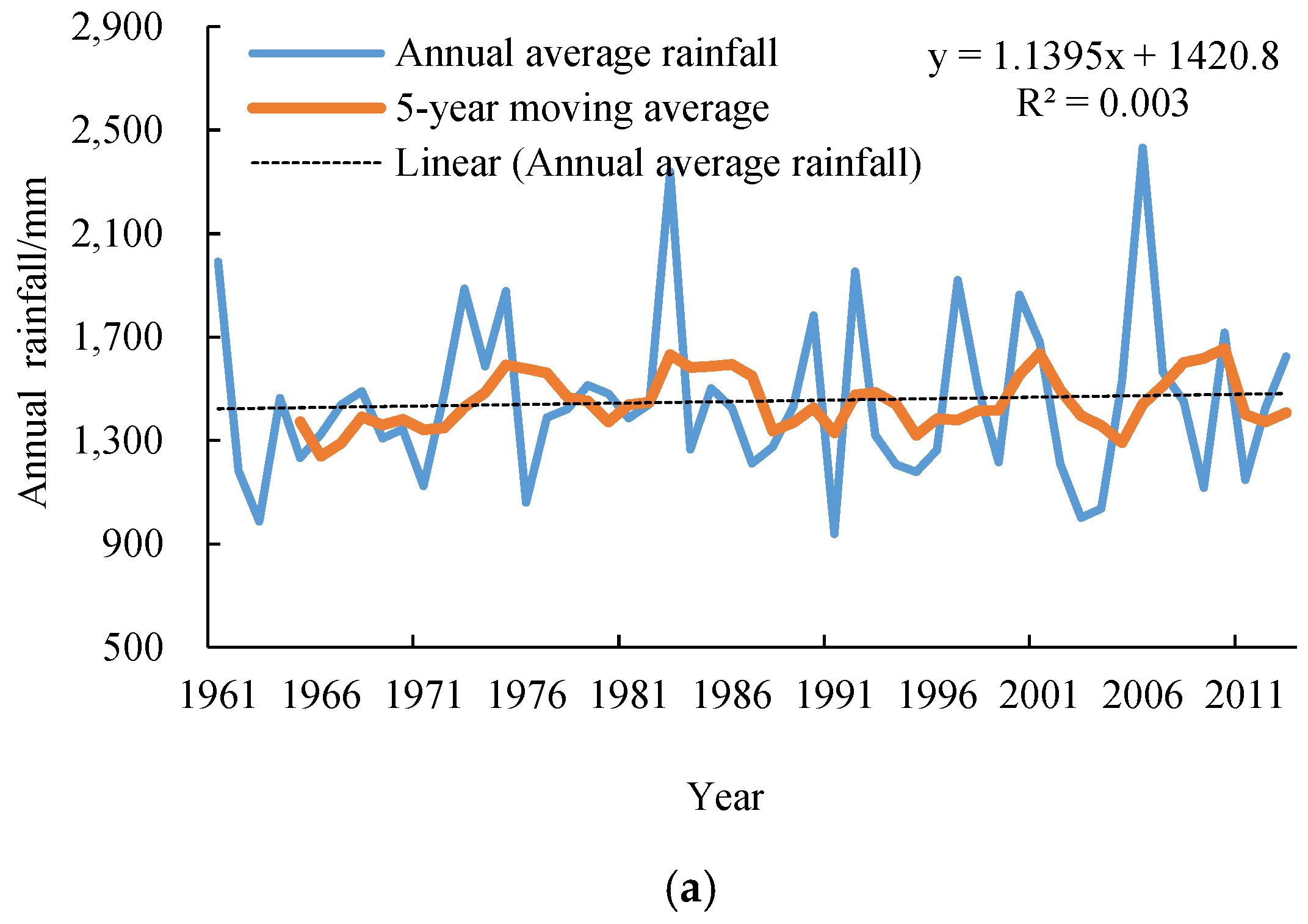

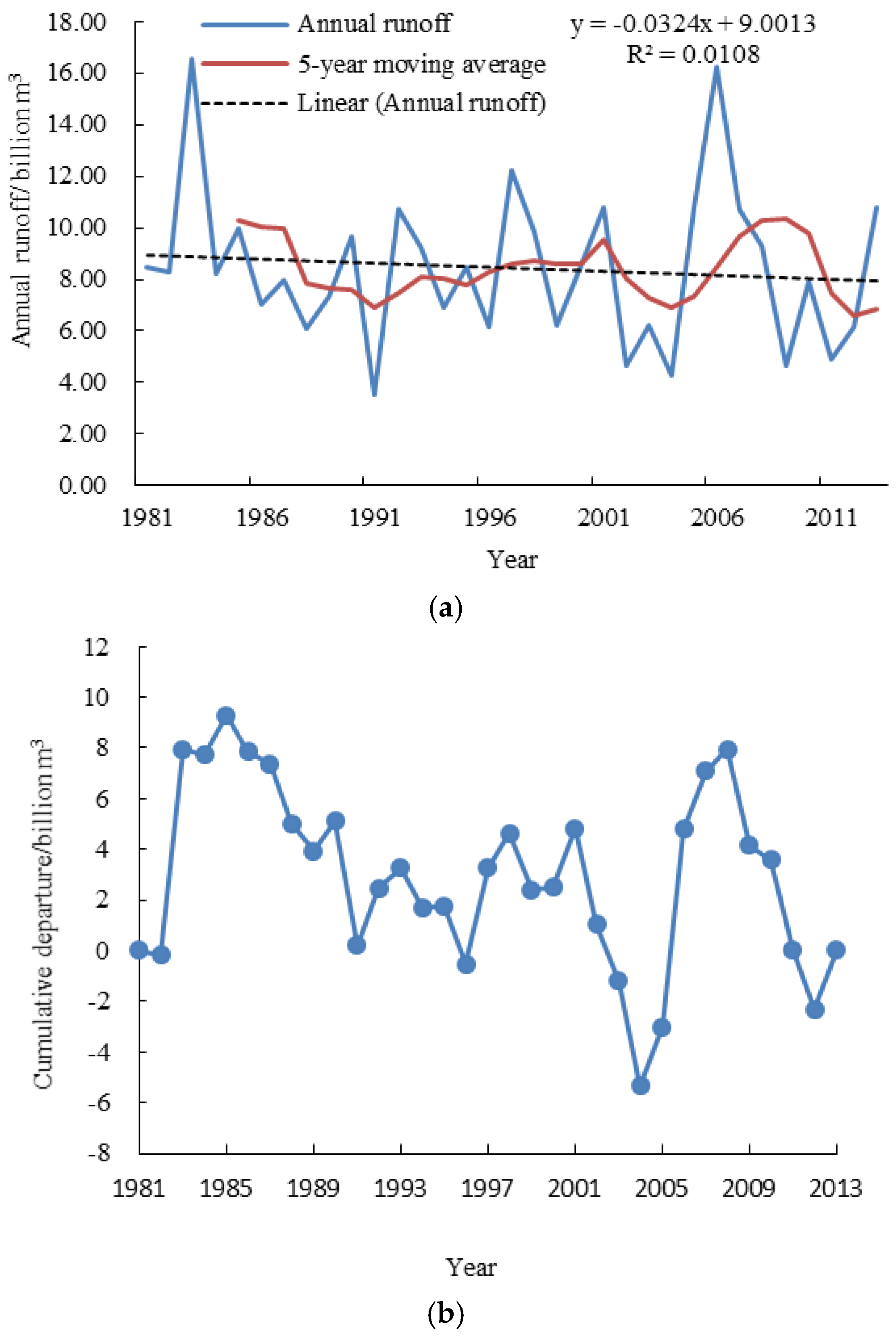
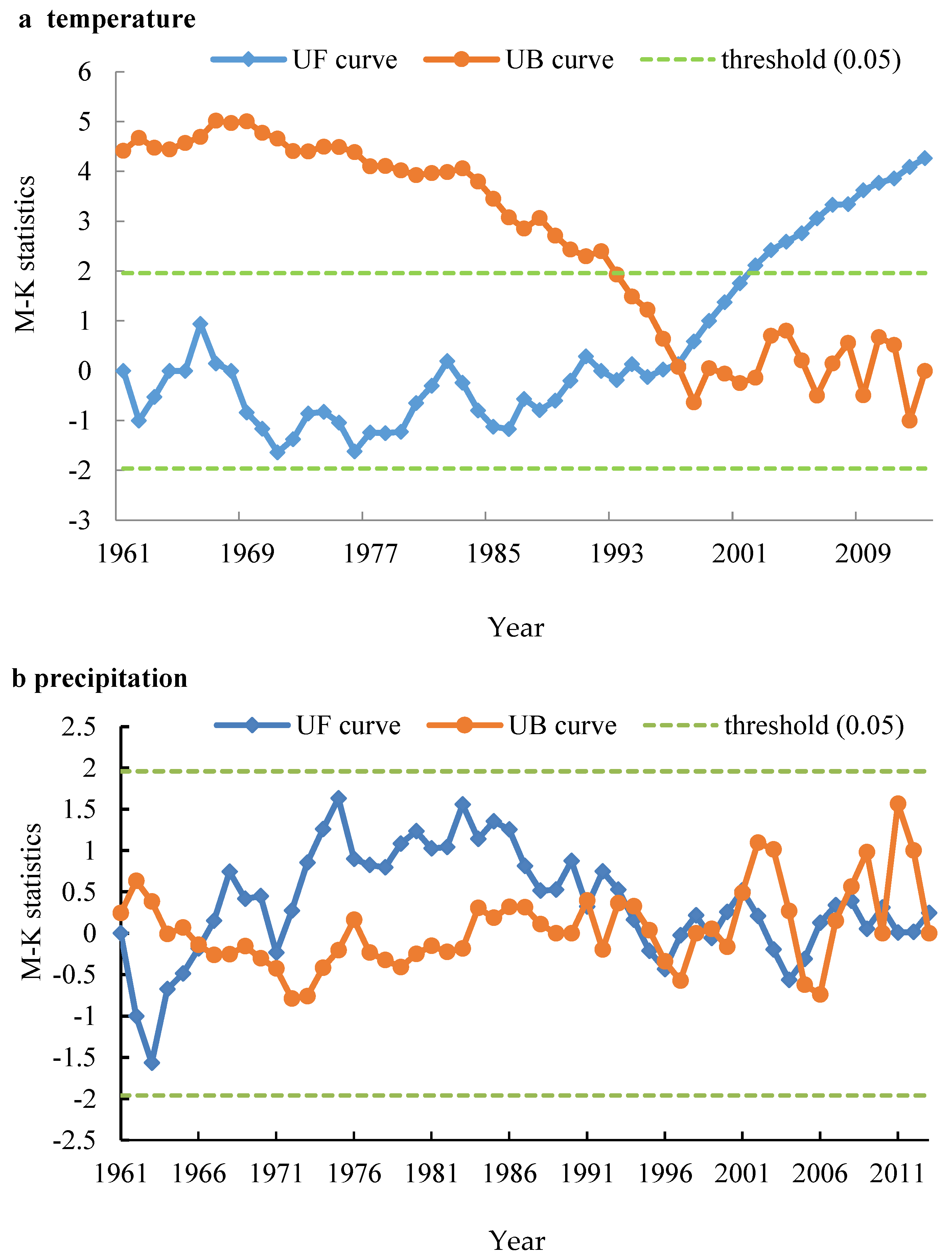
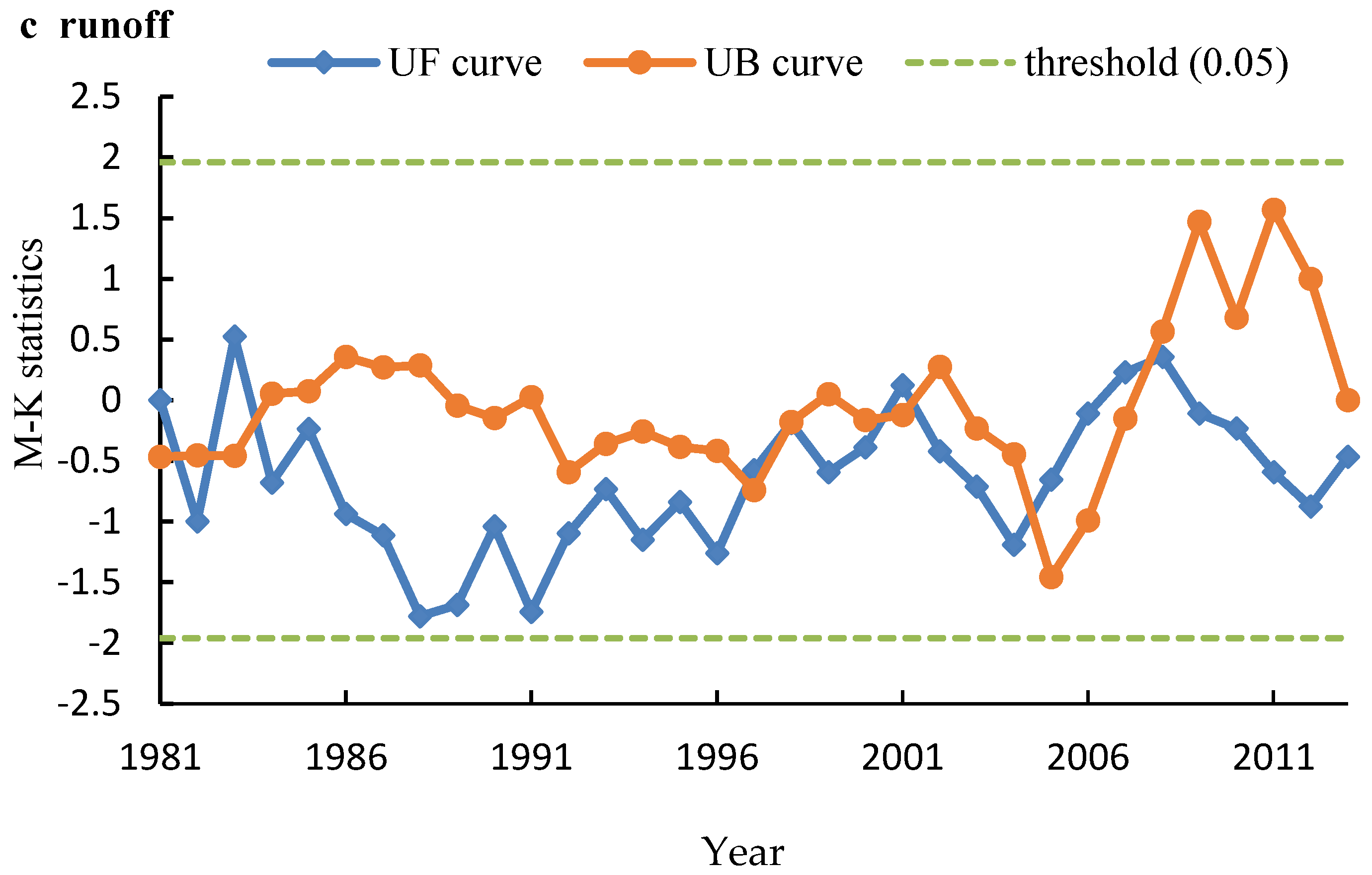
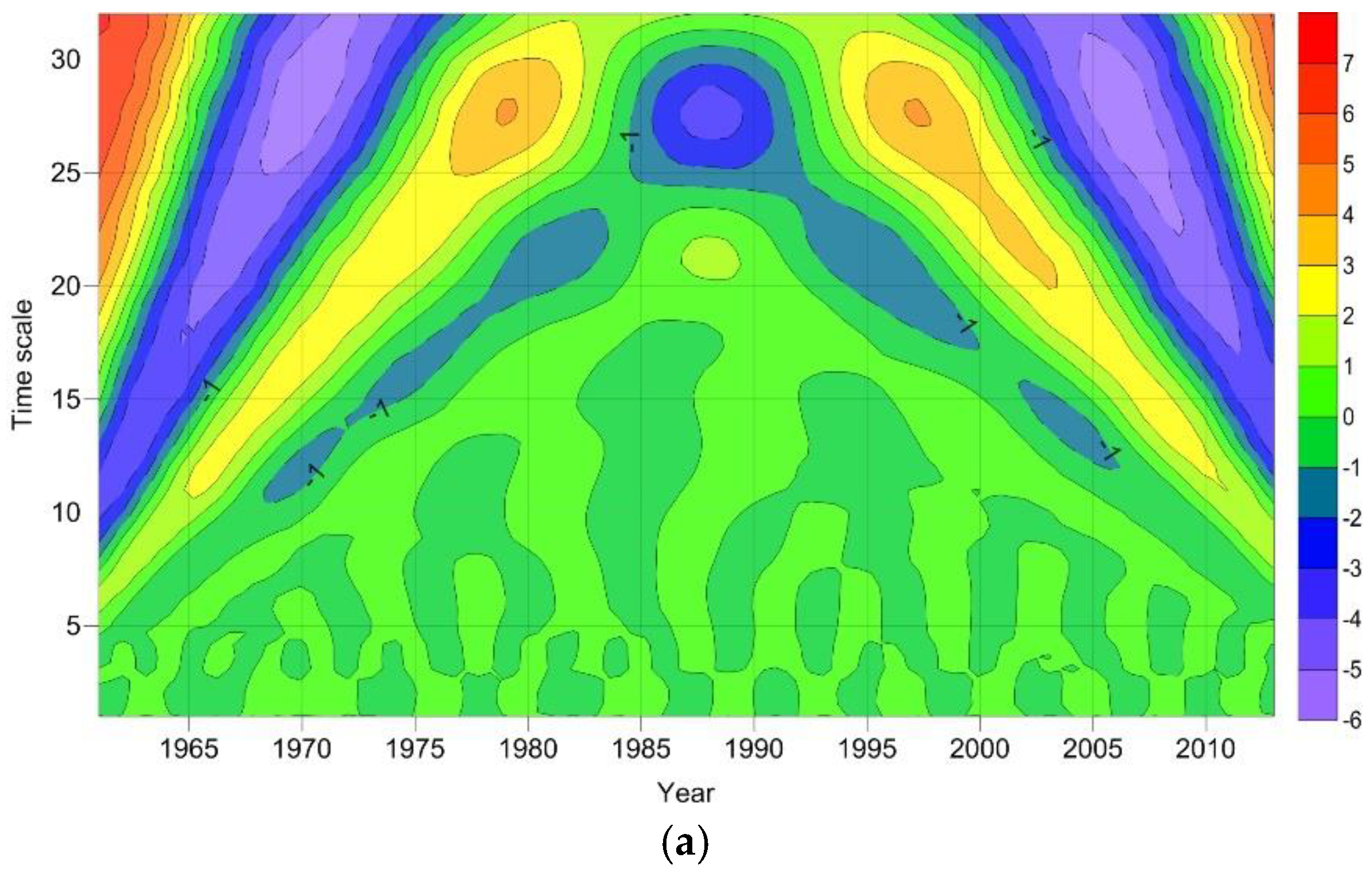

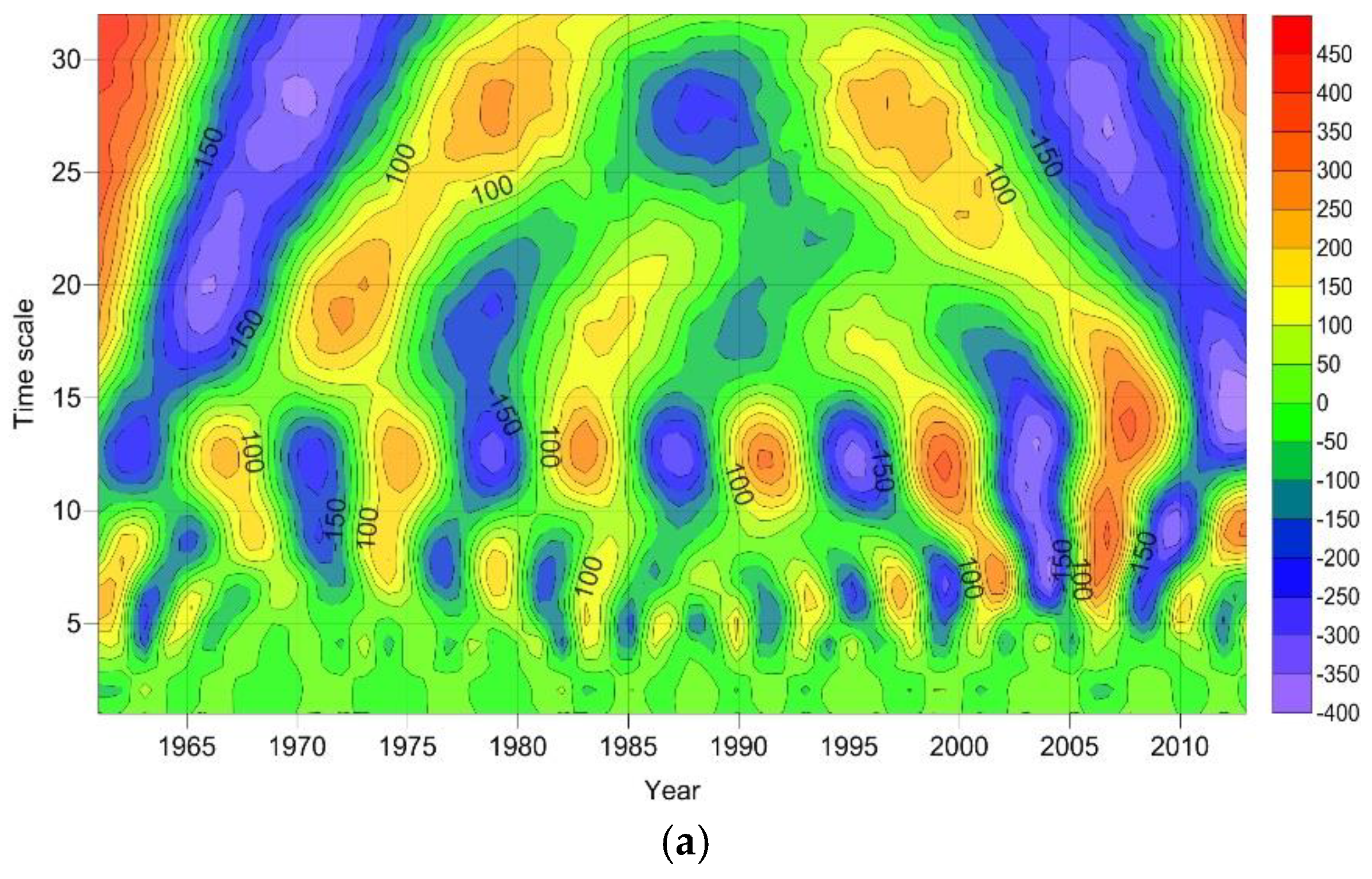

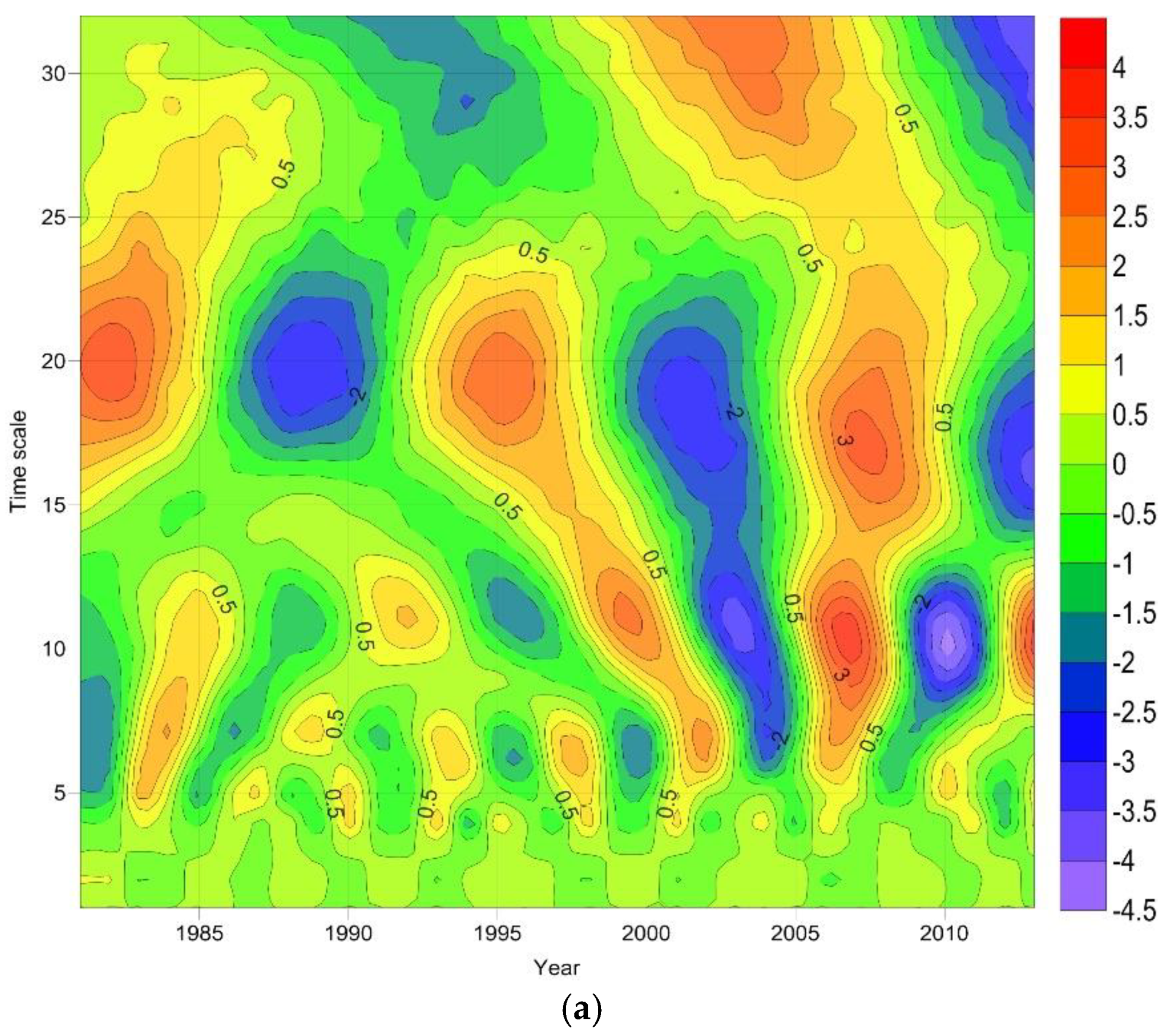
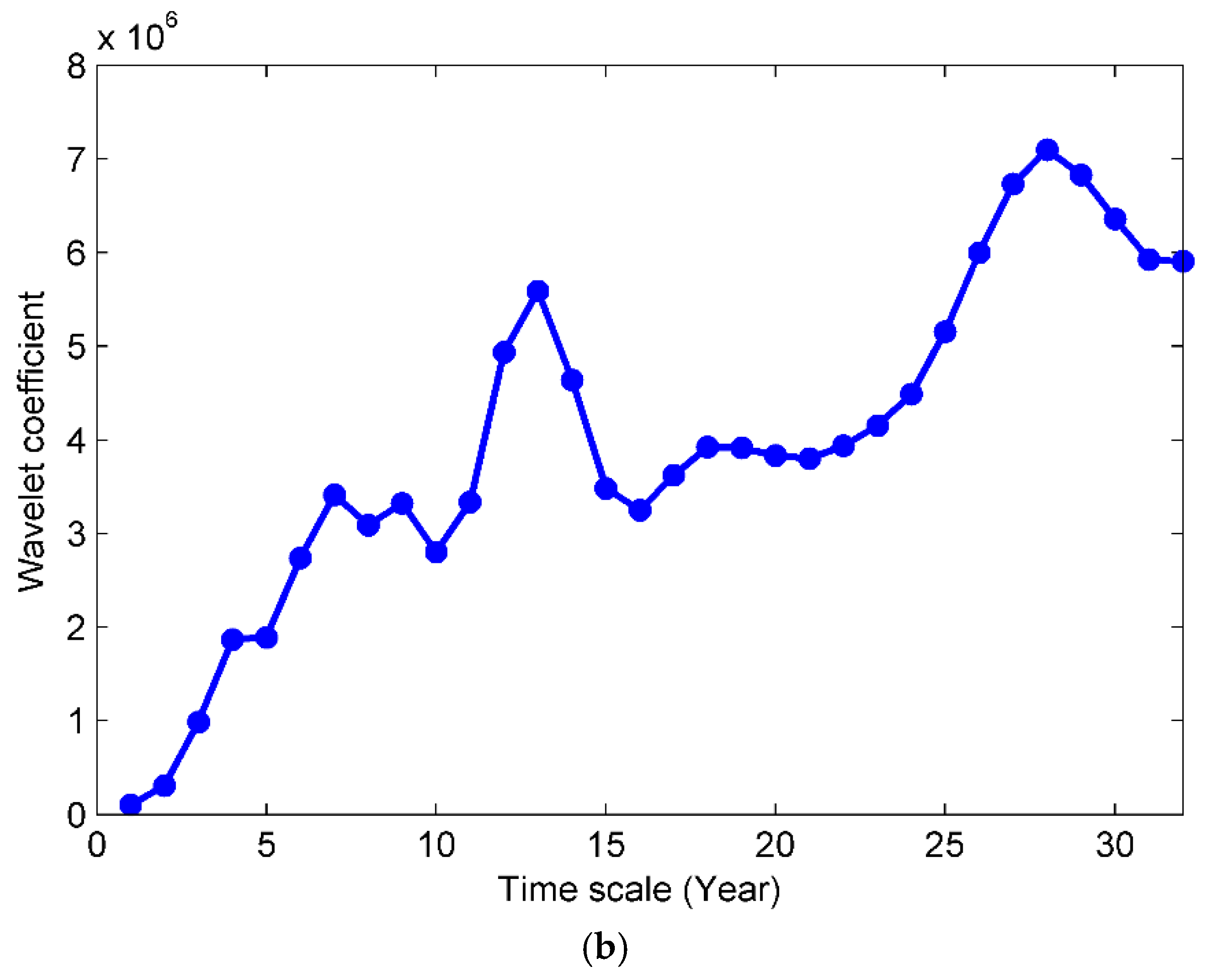

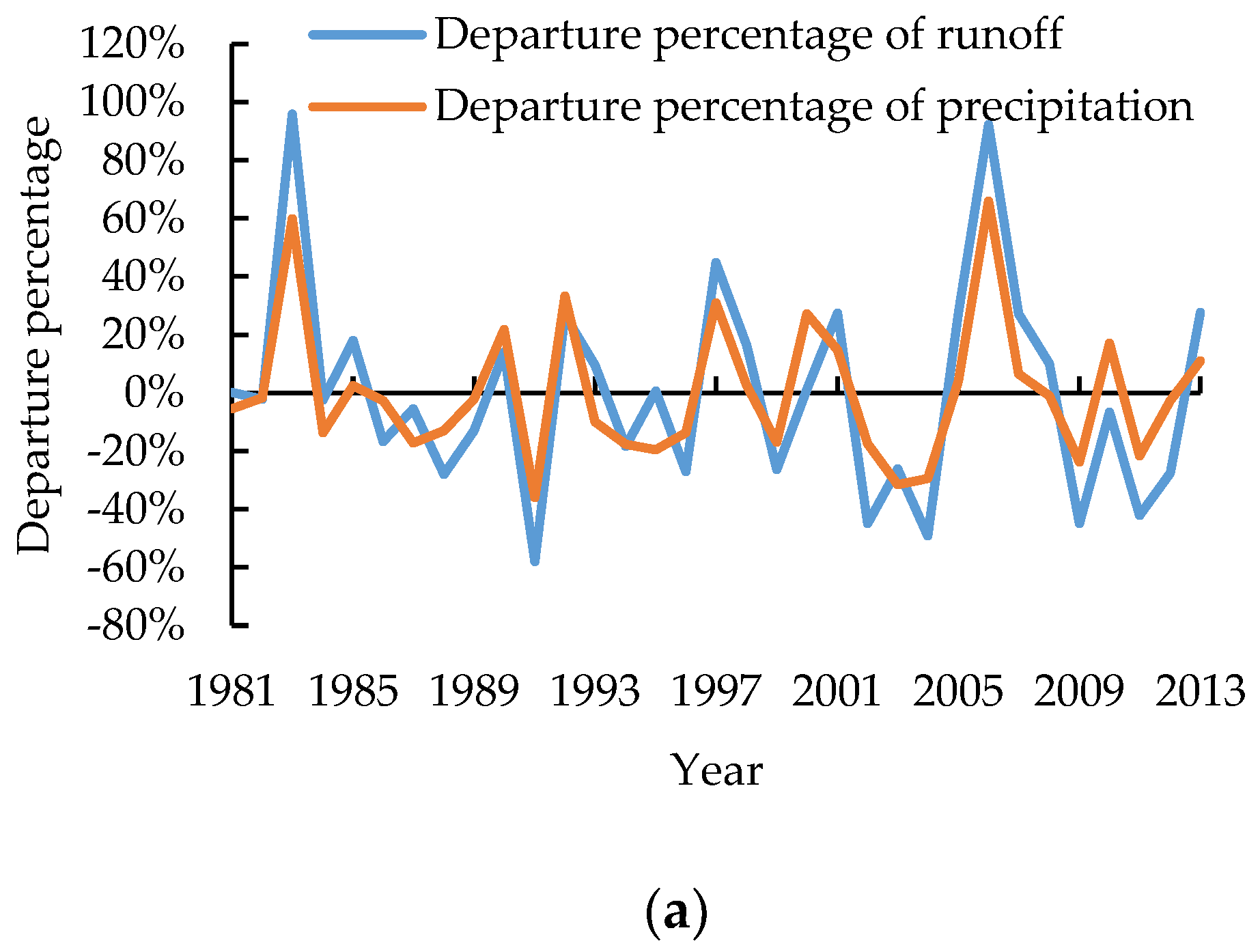
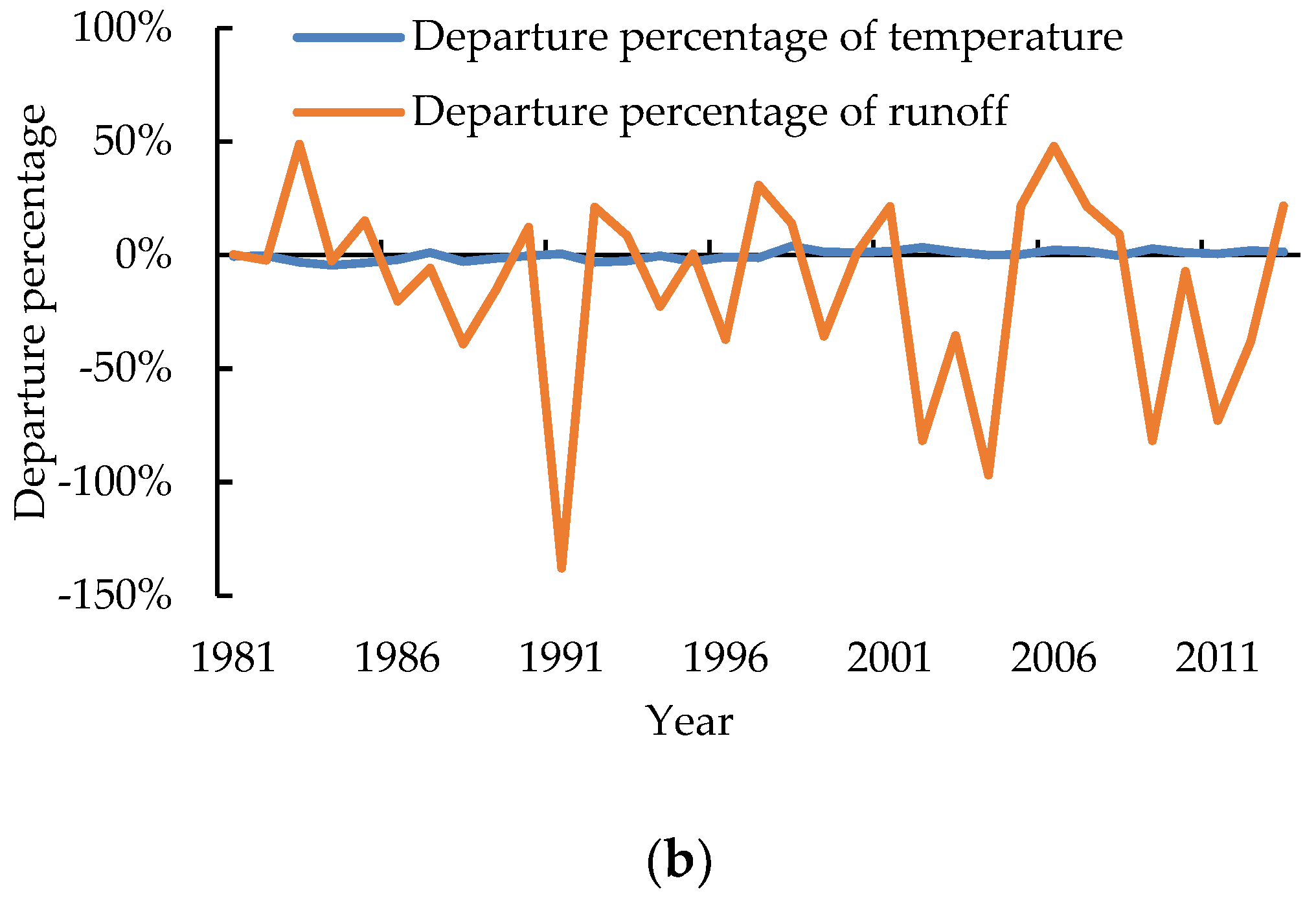

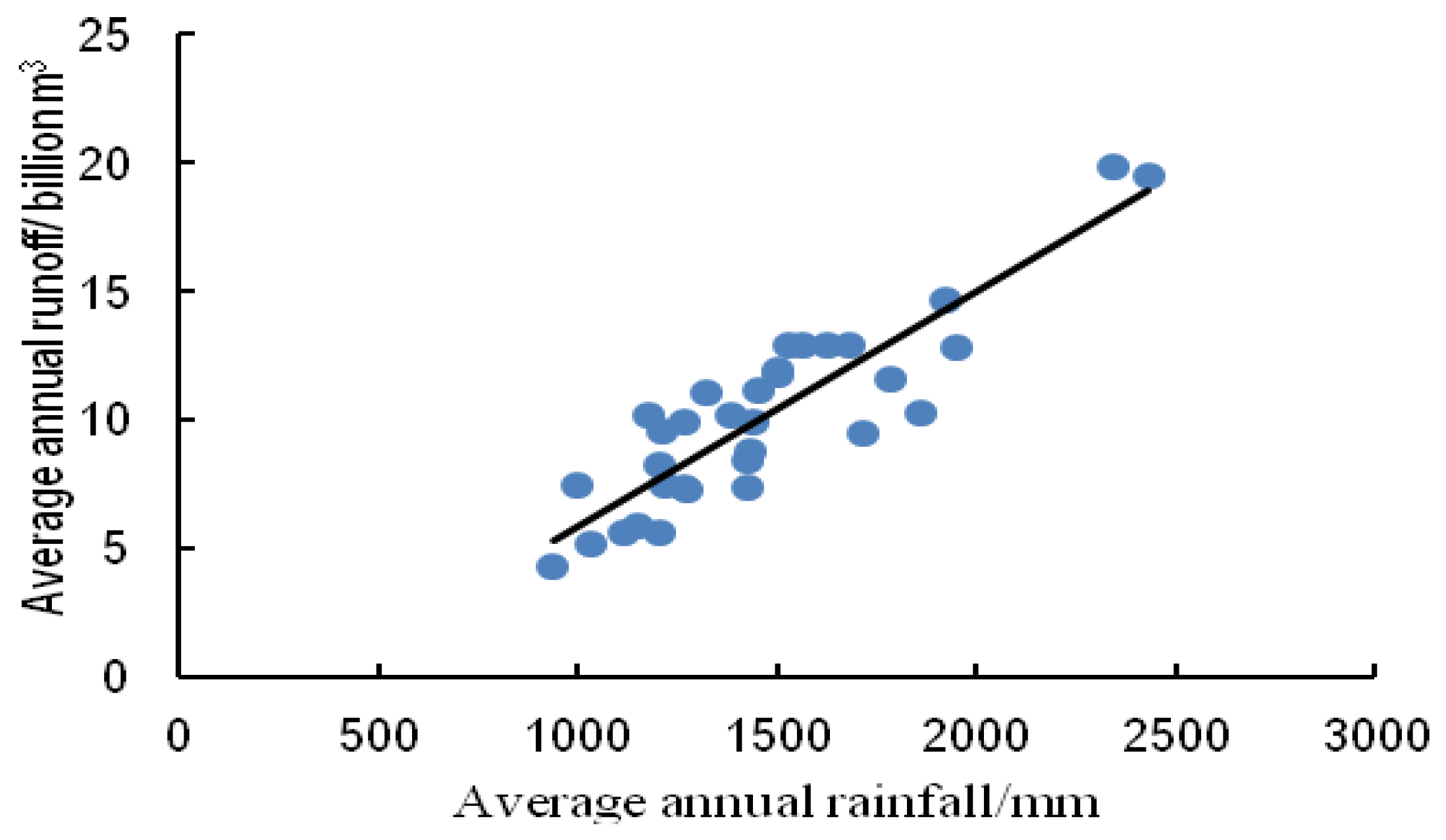

| Year | Cultivated Land | Forestland | Grassland | Watershed | Construction Land | |
|---|---|---|---|---|---|---|
| Area/km2 | 1990 | 313.19 | 1417.2 | 42.73 | 17.2 | 42.51 |
| 2013 | 187.9 | 1322.62 | 138.66 | 15.06 | 168.11 | |
| Rate of change in the area/% | From 1990 to 2013 | −40 | −6.67 | 224.5 | −12.44 | 295.46 |
| From 1990 to 2013 | Grassland | Cultivated Land | Construction Land | Forestland | Watershed | Total in 2013 |
|---|---|---|---|---|---|---|
| Cultivated land | 4.13 | 94.85 | 9.90 | 81.09 | 2.68 | 185.44 |
| Forestland | 21.82 | 106.85 | 1.96 | 1145.84 | 1.58 | 1315.66 |
| Grassland | 9.80 | 41.21 | 5.04 | 83.56 | 2.42 | 138.03 |
| Watershed | 0.79 | 2.47 | 0.68 | 4.21 | 8.29 | 15.94 |
| Construction land | 4.66 | 68.31 | 24.73 | 83.77 | 2.11 | 167.87 |
| Total in 1990 | 42.73 | 313.19 | 41.51 | 1416.46 | 17.2 | 1832 |
| From 1990 to 2013 | Grassland | Cultivated Land | Construction Land | Forestland | Watershed |
|---|---|---|---|---|---|
| Cultivated land | 2.22 | 51.15 | 1.56 | 43.73 | 1.34 |
| Forestland | 1.99 | 9.39 | 0.12 | 88.29 | 0.2 |
| Grassland | 4.2 | 31.31 | 0.75 | 60.55 | 3.2 |
| Watershed | 4.94 | 15.5 | 1.13 | 26.41 | 52 |
| Construction land | 2.62 | 45.15 | 3.78 | 47.06 | 1.35 |
| Year | Precipitation | Runoff Per Ten Thousand Tons | Impact of Precipitation | Impact of Human Activities | ||||
|---|---|---|---|---|---|---|---|---|
| (mm) | Actual Value | Calculated Value | Total Reduction | Quantity Affected/Hundred Million m3 | Contribution Factor | Quantity Affected/ Hundred Million m3 | Contribution Factor | |
| 1981–1985 | 1586.3 | 10.29 | ||||||
| 1986–1989 | 1336.1 | 7.14 | 7.59 | 3.15 | 0.45 | 14.3% | 2.7 | 85.7% |
| 1990–1999 | 1428.2 | 8.31 | 8.68 | 1.98 | 0.37 | 18.7% | 1.61 | 81.3% |
| 2000–2009 | 1487.8 | 8.64 | 9.25 | 1.65 | 0.61 | 37% | 1.04 | 63% |
| 2010–2013 | 1478.9 | 7.44 | 8.13 | 2.85 | 0.69 | 24.2% | 2.16 | 75.8% |
| 1986–2013 | 1443.6 | 8.46 | 8.72 | 1.83 | 0.26 | 14.2% | 1.57 | 85.8% |
© 2018 by the authors. Licensee MDPI, Basel, Switzerland. This article is an open access article distributed under the terms and conditions of the Creative Commons Attribution (CC BY) license (http://creativecommons.org/licenses/by/4.0/).
Share and Cite
Zhang, Z.; Wan, L.; Dong, C.; Xie, Y.; Yang, C.; Yang, J.; Li, Y. Impacts of Climate Change and Human Activities on the Surface Runoff in the Wuhua River Basin. Sustainability 2018, 10, 3405. https://doi.org/10.3390/su10103405
Zhang Z, Wan L, Dong C, Xie Y, Yang C, Yang J, Li Y. Impacts of Climate Change and Human Activities on the Surface Runoff in the Wuhua River Basin. Sustainability. 2018; 10(10):3405. https://doi.org/10.3390/su10103405
Chicago/Turabian StyleZhang, Zhengdong, Luwen Wan, Caiwen Dong, Yichun Xie, Chuanxun Yang, Ji Yang, and Yong Li. 2018. "Impacts of Climate Change and Human Activities on the Surface Runoff in the Wuhua River Basin" Sustainability 10, no. 10: 3405. https://doi.org/10.3390/su10103405





